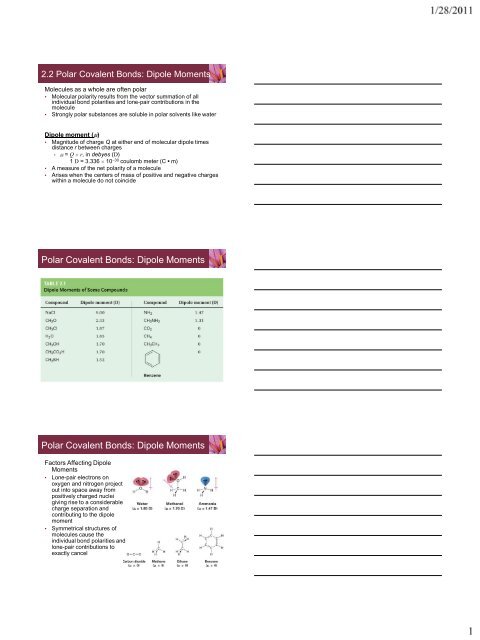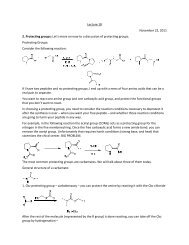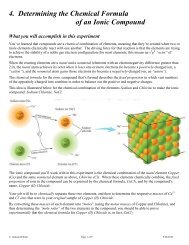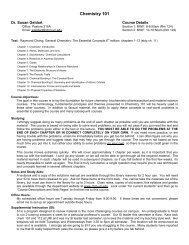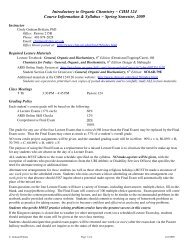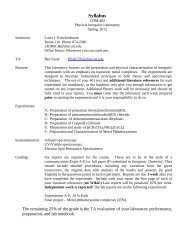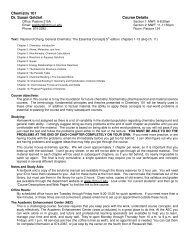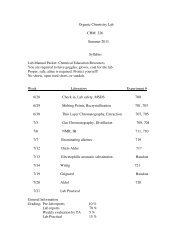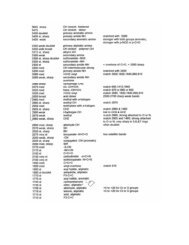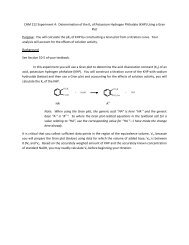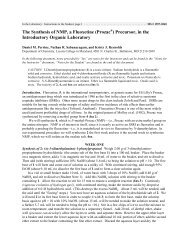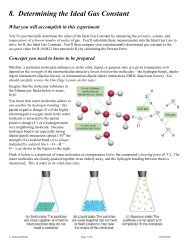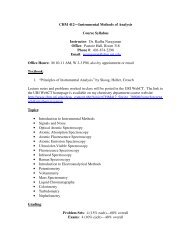Dipole Moments Polar Covalent Bonds: Dipole Moments
Dipole Moments Polar Covalent Bonds: Dipole Moments
Dipole Moments Polar Covalent Bonds: Dipole Moments
Create successful ePaper yourself
Turn your PDF publications into a flip-book with our unique Google optimized e-Paper software.
2.2 <strong>Polar</strong> <strong>Covalent</strong> <strong>Bonds</strong>: <strong>Dipole</strong> <strong>Moments</strong>Molecules as a whole are often polar• Molecular polarity results from the vector summation of allindividual bond polarities and lone-pair contributions in themolecule• Strongly polar substances are soluble in polar solvents like water<strong>Dipole</strong> moment ( )• Magnitude of charge Q at either end of molecular dipole timesdistance r between charges• = Q r, in debyes (D)1 D = 3.336 10 30 coulomb meter (C • m)• A measure of the net polarity of a molecule• Arises when the centers of mass of positive and negative chargeswithin a molecule do not coincide<strong>Polar</strong> <strong>Covalent</strong> <strong>Bonds</strong>: <strong>Dipole</strong> <strong>Moments</strong><strong>Polar</strong> <strong>Covalent</strong> <strong>Bonds</strong>: <strong>Dipole</strong> <strong>Moments</strong>Factors Affecting <strong>Dipole</strong><strong>Moments</strong>• Lone-pair electrons onoxygen and nitrogen projectout into space away frompositively charged nucleigiving rise to a considerablecharge separation andcontributing to the dipolemoment• Symmetrical structures ofmolecules cause theindividual bond polarities andlone-pair contributions toexactly cancel
Worked Example 2.1Predicting the Direction of a <strong>Dipole</strong> MomentMake a three-dimensional drawing of methylamine,CH 3 NH 2 , and show the direction of its dipolemoment ( = 1.31)2.3 Formal ChargesFormal charge• The difference in the number of electrons owned by an atom in a molecule andby the same atom in its elemental state• Formal charges do not imply the presence of actual ionic charges• Device for electron “bookkeeping”• Assigned to specific atoms within a molecule• Dimethyl sulfoxide CH 3 SOCH 3• Sulfur atom has three bonds rather than the usual two and has a formalpositive charge• Oxygen atom has one bond rather than the usual two and has a formalnegative chargeFormal ChargesFormal Charge Determination
Formal ChargesFormal Charges2.4 ResonanceTwo different ways to draw the acetate ion• Double bond placement• Neither structure correct by itself• True structure is intermediate between the two• Two structures are known as resonance forms
ResonanceResonance forms• Individual line-bondstructures of a molecule orion that differ only in theplacement of andnonbonding valenceelectrons• Indicated by “ ”• Resonance formscontribute to a single,unchanging structurethat is the resonancehybrid of the individualforms and exhibits thecharacteristics of allcontributorsResonanceBenzene has two equivalent resonance forms• The true structure of benzene is a hybrid of the twoindividual forms, and all six carbon-carbon bonds areequivalent• Symmetrical distribution of electrons is evident in anelectrostatic potential map of benzene2.5 Rules for Resonance FormsRule 1 – Individual resonance forms are imaginary, notreal• Real structure is a compositeRule 2 – Resonance forms differ only in the placement oftheir or nonbonding electrons
Rules for Resonance Forms• electrons in double bonds of benzene move• Electron movement is indicated by curved arrow formalism• Curved arrows indicate electron flow, not the movement ofatoms• A curved arrow indicates that a pair of electrons movesfrom the atom or bond at the tail of the arrow to the atom orbond at the head of the arrowRules for Resonance FormsRule 3 – Different resonance forms of a substrate do nothave to be equivalentRules for Resonance FormsRule 4 – Resonance forms obey normal rules of valency(follow the octet rule)Rule 5 – The resonance hybrid is more stable than anyindividual resonance form• Resonance leads to stability
2.6 Drawing Resonance FormsIn general any three-atom grouping with a p orbital on each atomhas two resonance forms:• The atoms X,Y, and Z in the general structure might be C,N,O,P,or S• The asterisk (*) on atom Z for the resonance form on the left mightmean that the p orbital is:• Vacant• Contains a single electron• Contains a lone pair of electronsDrawing Resonance FormsReaction of pentane-2,4-dione with a base• H + is removed• An anion is formedResonance of the anion product:Worked Example 2.2Drawing Resonance Forms of an AnionDraw three resonance forms for the carbonate ion, CO 32-.
Worked Example 2.3Drawing Resonance Forms for a RadicalDraw three resonance forms for the pentadienyl radical. Aradical is a substance that contains a single, unpairedelectron in one of its orbitals, denoted by a dot (•).


